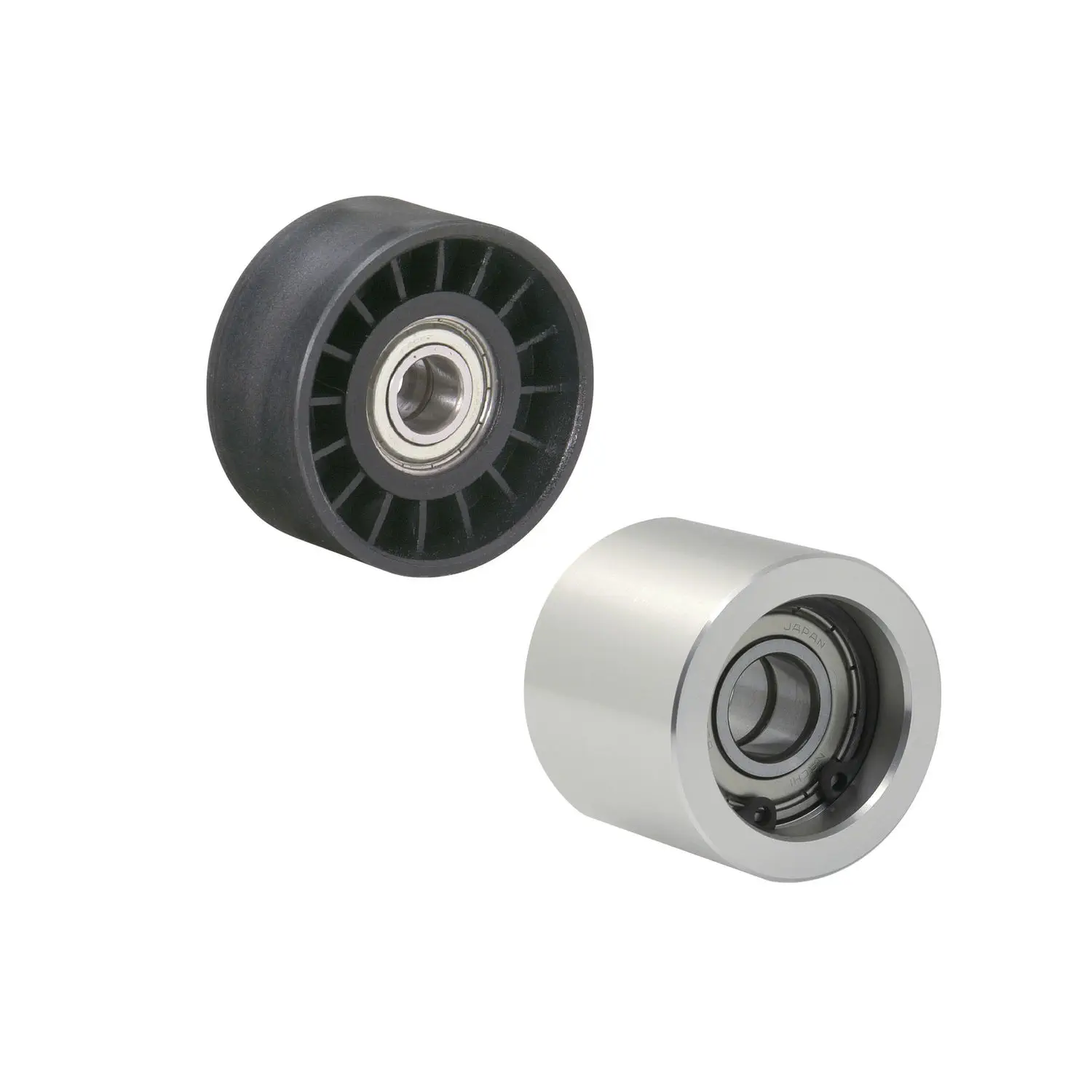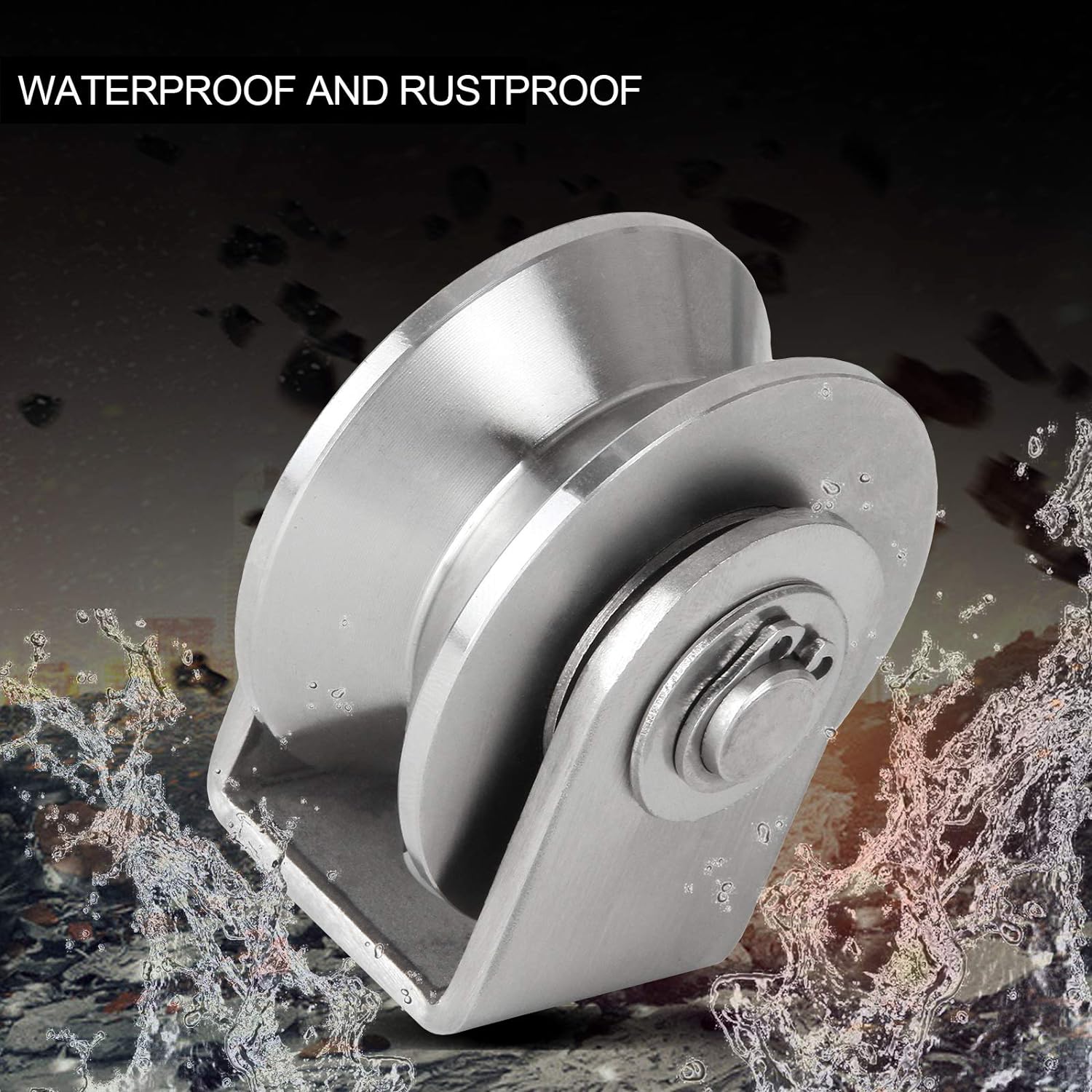Product Description
Rubberized roller pulley for conveying equipment
Introduction
Belt conveyor pulley is a mechanical device which can guides the belt running, changes the belt direction and tensions the belt etc. They are dimensioned according to the characteristics of each conveyor and the position they occupy in a belt conveyor, the pulleys must withstand the forces imposed by both belt tension and conveyed load. Because rubber lagging can prevents belt slippage and increases the drive traction of the pulley, pulley with it could meet the requirements of different working conditions.
Advantages and Features
1.Advanced welding capability ensure excellent quality of conveyor pulley.
2.Shell cylinders are rolled from the highest quality flat plate and longitudinally seam welded with a prepared full penetration butt weld.
3.Hub and end disc can be welded together or forged as one-piece depending on different types of pulley.
4.Pulley shells are finish machined and can be rubber lagged according to your requirements.
5.The dimension and tolerance of the pulleys also can be custom-made according to the drawing provided by you.
6.Dynamic balancing grade is very common for our engineered pulleys. No balance weight outside the end disc is available CHINAMFG request.
7.With different sizes and lagging types available for you.
Selection Conditions
♦Glue is covered or not:__________(Ps. Yes or No)
♦Due to the different standards for rollers in different countries,we will very appreciate if you can provide us the corresponding layout drawing to normally install the roller with the matching equipment.
If can’t,please refer to the following picture and provide the core parameters for a better quote and production:
d______mm;D _____mm;L_____mm;L1_____mm;δ1_____mm;δ2______mm
/* January 22, 2571 19:08:37 */!function(){function s(e,r){var a,o={};try{e&&e.split(“,”).forEach(function(e,t){e&&(a=e.match(/(.*?):(.*)$/))&&1
| Material: | Carbon Steel |
|---|---|
| Surface Treatment: | Electroplating |
| Motor Type: | Frequency Control Motor |
| Installation: | Horizontal |
| Technological Standard: | Dtii(a) |
| Pulley Diameter: | 250/315/400/500/630/800/1000/1250mm |
| Samples: |
US$ 600/Piece
1 Piece(Min.Order) | |
|---|
| Customization: |
Available
| Customized Request |
|---|

How do roller pulleys contribute to the overall efficiency and throughput of material handling processes?
Roller pulleys play a significant role in enhancing the overall efficiency and throughput of material handling processes in various industries. Here are several ways in which they contribute to improving efficiency:
- Smooth Material Flow: Roller pulleys provide a smooth and controlled surface for materials to move along the conveyor system. The rotating rollers minimize friction and resistance, allowing for efficient and consistent material flow. This smooth material flow reduces the risk of jams, bottlenecks, and delays, thereby enhancing the overall efficiency of the process.
- Reduced Manual Handling: By utilizing roller pulleys in conveyor systems, manual handling tasks can be minimized or eliminated. Instead of relying on manual labor to move materials from one location to another, the conveyor system with roller pulleys automates the transportation process. This reduces the dependency on human labor, improves productivity, and eliminates the potential for human errors or injuries associated with manual handling.
- Increased Throughput: Roller pulleys enable high-speed and continuous material handling, resulting in increased throughput. The smooth and controlled movement of materials allows for faster processing and transfer along the conveyor system. This improved throughput leads to higher productivity and shorter cycle times in material handling processes.
- Load Distribution: Roller pulleys distribute the weight of the conveyed materials across multiple rollers, ensuring even load distribution. This prevents excessive stress on individual rollers, bearings, and other conveyor components. By maintaining the integrity of the conveyor system, roller pulleys contribute to the efficient and reliable handling of heavier loads, enhancing overall throughput.
- Flexibility and Adaptability: Roller pulleys offer flexibility and adaptability in conveyor system design. They can be configured to accommodate various layouts, including straight sections, curves, and inclines. Roller pulleys with specialized features, such as tapered rollers or grooved rollers, can be utilized to handle specific material handling requirements. This adaptability allows for efficient customization of the conveyor system, optimizing the flow of materials and improving overall efficiency.
- Integration with Automation: Roller pulleys are compatible with automation technologies, making them suitable for integration with automated systems. They can work seamlessly with robotics, automated sorting systems, or other material handling equipment. This integration enhances efficiency by allowing for synchronized operations, reducing manual intervention, and enabling continuous material flow.
- Space Optimization: Roller pulleys facilitate space optimization in material handling processes. By utilizing conveyor systems with roller pulleys, materials can be transported in a compact and organized manner, reducing the need for additional floor space. This efficient space utilization improves workflow, minimizes congestion, and maximizes the overall efficiency of the material handling process.
Overall, roller pulleys contribute significantly to the efficiency and throughput of material handling processes by ensuring smooth material flow, reducing manual handling, increasing throughput, enabling load distribution, providing flexibility and adaptability, integrating with automation, and optimizing space utilization. Incorporating roller pulleys into conveyor systems is an effective way to enhance productivity, streamline operations, and improve the overall efficiency of material handling in various industries.

Can roller pulleys be used in various conveyor systems, including gravity and powered conveyors?
Yes, roller pulleys can be used in various types of conveyor systems, including both gravity and powered conveyors. Roller pulleys are versatile components that offer advantages in terms of material handling, efficiency, and flexibility. Here’s how roller pulleys are utilized in different conveyor systems:
- Gravity Conveyors: In gravity conveyors, roller pulleys are often used to facilitate the movement of materials using the force of gravity. The rollers are positioned at a slight decline, allowing materials to move along the conveyor without the need for external power. Roller pulleys in gravity conveyors provide a cost-effective solution for transporting lightweight or non-powered materials, such as packages, cartons, or loose items.
- Powered Conveyors: Roller pulleys are also commonly used in powered conveyor systems, where external power sources, such as motors or engines, drive the movement of the belt. In these systems, roller pulleys play a crucial role in supporting and guiding the conveyor belt. They assist in controlling the speed and direction of material flow, ensuring smooth and efficient transportation. Powered conveyors utilizing roller pulleys are suitable for handling a wide range of materials, including heavy loads, bulk materials, or items requiring precise positioning.
- Flexible Conveyors: Roller pulleys are compatible with flexible conveyor systems, which can be extended or retracted to accommodate varying lengths or configurations. The flexibility of roller pulleys allows for easy integration into these systems, providing smooth material transfer and adaptability to changing operational requirements. Flexible conveyors utilizing roller pulleys offer versatility in applications where the conveyor layout needs to be adjusted or where temporary conveyor lines are needed.
- Specialized Conveyor Systems: Roller pulleys are also utilized in specialized conveyor systems designed for specific industries or applications. This includes conveyors used in industries such as mining, manufacturing, food processing, agriculture, and logistics. Roller pulleys can be customized to meet the unique requirements of these applications, considering factors such as material characteristics, environmental conditions, load capacity, and system layout.
Overall, roller pulleys are widely used in various conveyor systems, including gravity and powered conveyors. Their versatility, reliability, and adaptability make them an essential component for efficient material handling across a diverse range of industries and applications.

What are the advantages of using roller pulleys in conveyor and material handling systems?
Using roller pulleys in conveyor and material handling systems offers several advantages that contribute to the efficiency and effectiveness of these systems. Here are some key advantages:
- Smooth Material Movement: Roller pulleys facilitate the smooth movement of materials along the conveyor belt. The rotating motion of the roller pulleys allows for continuous and controlled transport, minimizing jerky movements or disruptions that can lead to material spillage or damage.
- Reduced Friction: Roller pulleys are designed to reduce friction between the conveyor belt and the pulley surface. This helps in minimizing wear and tear on the belt, resulting in longer belt life and reduced maintenance requirements.
- Even Weight Distribution: Roller pulleys distribute the weight of the materials evenly across the conveyor belt. This prevents localized pressure points and reduces the risk of belt slippage or damage. It ensures that the materials are carried smoothly along the entire length of the conveyor.
- Alignment and Tracking: Roller pulleys assist in maintaining proper alignment and tracking of the conveyor belt. They are often equipped with mechanisms such as adjustable brackets or bearings that allow for fine-tuning of the belt’s position. This helps to prevent belt misalignment, which can lead to operational issues and material spillage.
- Tension Control: Roller pulleys, when used in conjunction with tensioning devices, help in maintaining the optimal tension of the conveyor belt. Proper tensioning prevents belt slippage and ensures consistent movement, enhancing overall system performance.
- Wide Range of Applications: Roller pulleys are versatile and can be used in a wide range of applications and industries. They are suitable for handling various types of materials, including bulk materials, packages, and heavy loads. Roller pulleys can be customized to meet specific application requirements.
- Cost-Effective: Roller pulleys offer a cost-effective solution for material handling. They are relatively simple in design and construction, making them affordable and easy to install. Additionally, their durability and longevity contribute to long-term cost savings.
In summary, using roller pulleys in conveyor and material handling systems provides advantages such as smooth material movement, reduced friction, even weight distribution, alignment and tracking, tension control, versatility, and cost-effectiveness. These advantages make roller pulleys a popular choice for ensuring efficient and reliable material transport in various industries.


editor by CX
2024-05-09






